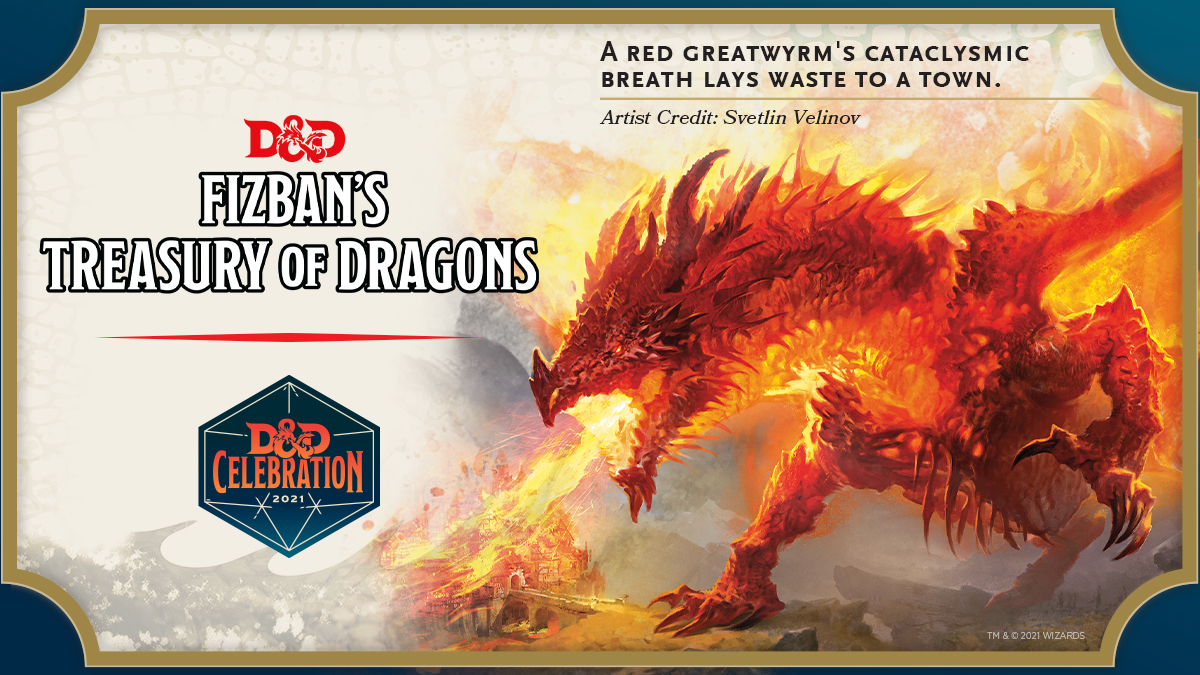Fizban’s Treasury of Dragons introduces the demigod-like Greatwyrm. But as it turns out, they need the Monster Manual to be truly great.
Dragons are one of the most fearsome foes in all of D&D. Or at least, they should be. They’re right there in the game’s name.
But on occasion, a fight with a dragon can undercut their own nature. Dragons, for all their powers and abilities, struggle to deal enough damage to feel like a significant threat. Chromatic dragons in particular have difficulties as a “boss encounter.”
The biggest reason for this? The way the 5th Edition is structured.
It’s Hard Out Here for a Dragon
Even if a dragon out-levels an adventuring party, the odds still favor the party (unless they are the lowest of low levels). It makes sense; you’re getting 4-5 turns to each of the dragon’s single turns.
And while the dragon gets additional legendary actions, it still doesn’t get the full might of its stat block but once per round. It’s hard to compete with the economy of actions a party has if you’re just flying solo in a boss fight.
And that’s not the only tricky part. Dragons, especially chromatic dragons, tend to only do damage. While metallic dragons have some disabling effects with their breath weapons, that only goes so far.
Enter the Greatwyrm
Greatwyrms are the newest age category for dragons introduced in Fizban’s Treasury of Dragons. They represent the pinnacle of draconic power.
An ancient dragon might extend its consciousness across realities, coming into contact with “draconic echoes” of itself on multiple planes. It can then fuse with them to become a singular entity– and then its might approaches divinity.
In short? Dragons can Jet Li’s The One their way into power. They’re supposed to become dire threats capable of razing whole cities by themselves!
Weighing in at CRs 26-28, they’re up there with the mightiest of monsters in the manual. But if you look at the stat block for one of the Greatwyrms, you’ll find that they all too often end up the same way.
They all still make the standard claw-claw-bite attack, or they can use their tails or their breath weapon. And that’s about it.
They have some unique legendary actions, like creating spears of magical force that automatically hit a target (no roll needed). But that takes up their entire legendary action.
Greatwyrms are Mythic monsters, and that does work in their favor. What does being “mythic” mean? Once you drop their total hit points to 0, they immediately reset to a new hit point total.
That means they can recharge their breath weapons and regain uses of Legendary Resistance. They also gain new Mythic actions– but really, those actions just compete with the pool of Legendary actions for more use.
How Does a Variant Rule in the Monster Manual Help?
To answer that, we need to take a look at one of the new types of dragons in Fizban’s Treasury.
Gem dragons all have unique psychic powers that function exactly like spellcasters. Even the Gem Greatwyrm has access to spells. It comes default with dispel magic (3rd), forcecage (7th), plane shift (7th), reverse gravity (7th), and time stop (9th). And they’re all available to use once per day.
All Gem Dragons of young or higher-age have spells (though not nearly as high level). But a variant rule in the Monster Manual hangs out in the sidebar on page 86:
This rule states:
A young or older dragon can innately cast a number of spells equal to its Charisma modifier. Each spell can be cast once per day, requiring no material components, and the spell’s level can be no higher than one-third the dragon’s challenge rating (rounded down). The dragon’s bonus to hit with spell attacks is equal to its proficiency bonus + its Charisma bonus. The dragon’s spell save DC equals 8 + its proficiency bonus + its Charisma modifier.
All Dragons Have Access to Spells
It makes sense. Dragons are, after all, a whole origin story for sorcerers. And applying this rule to the spell-less Greatwyrms, Metallic and Chromatic, we see that they’re CR 28 and 27 respectively.
That means they can have up to 10 spells they can cast once per day, and that these spells can be up to 9th level. So you could take something like Meteor Swarm, Time Stop, Simulacrum, or even Wish and run it with a Greatwyrm.
This new rule can definitely help close the dragon-party power gap. It gives them things to do besides just dealing damage– and it can help cement their status as one of the most powerful beings in all of D&D: spellcasters.

Happy Adventuring!
Source: Bell of Lost Souls







